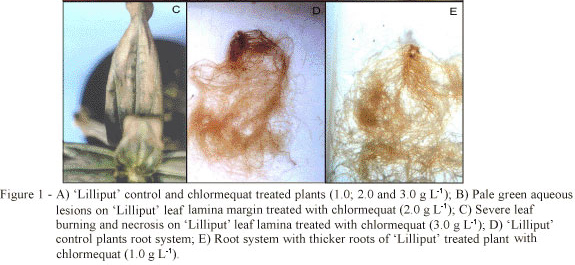Zinnias have good potential to be used as flowering, potted plants, being a quick source of novelty for the floriculture industry with the aid of growth retardants. This study evaluated the effect of growth retardants on development and production of short, compact and attractive plants of potted 'Lilliput' Zinnia elegans, a highly ornamental zinnia with low cost seeds. Trials were set up in randomized blocks, with ten treatments (control and three treatments of each retardant: daminozide, paclobutrazol and chlormequat) and four replications (two pots per experimental unit, with one plant per 0.6-L pot). Paclobutrazol (0.5, 0.75 and 1.0 mg a.i. per pot) and chlormequat (1.0, 2.0 and 3.0 g L-1) were applied as a single drench (40 mL per pot), and daminozide (2.5, 3.75 and 5.0 g L-1) as a single foliar spray to runoff (10 mL per pot), at apical flower bud stage. Daminozide (2.5 and 3.75 g L-1), paclobutrazol (0.5, 0.75 and 1.0 mg a.i. per pot) and chlormequat at 1.0 g L-1 significantly reduced plant height and side branches length, without affecting flower diameter, delaying production cycle and causing phytotoxicity symptoms. However, plants were not short and compact enough to meet market quality demand. Chlormequat (2.0 and 3.0 g L-1) caused phytotoxicity symptoms and daminozide (5.0 g L-1) delayed production cycle.
floriculture; daminozide; paclobutrazol; chlormequat; flowering









